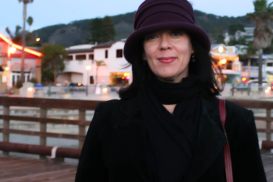by Xochitl-Julisa Bermejo
The Desert Lotus House for Writers is a new writing retreat in Joshua Tree, California, and is the passion project of WWS original member, Lisa Eve Cheby. Applications opened on 11/11/17 with residencies beginning in January 2018.
Women Who Submit: On the Desert Lotus House for Writers website, you mention time you spent at a residency in Knoxville, TN. Why did you want to start a writing retreat, and how did your residency experience help you create your own?
Lisa Eve Cheby: The residency at Firefly Farms and SAFTA was amazing. I had never been on a residency and doubted myself and what I would do with that gift of space and time. There was something about the process of applying and being accepted. It is not a fully-funded residency, but it was affordable and in a new place. The house was welcoming and comfortable. The landscape was new and beautiful. It was the first time in my adult life where I did not have an agenda. I was able to write and read poetry all day. I opted to not have a car that week, so I was really isolated to the farm and to walks on the property and neighborhood. All I had to do was feed the animal and write. I also loved having another poet in the house with me, in this case, Karen Craigo, and the writer in the “coop” who shared kitchen and bath with us, Sara Martin. We each retreated to our rooms or various places in the house to write, but cooking in the kitchen seemed to indicate we were open for conversation.
For about a year, I had been wanting to create a writing retreat for myself in Joshua Tree. The right place at the right price never really came along, and I am limited in what I can fund on my own. I was reluctant to Airbnb as I didn’t want to be a burden to the community. When I was in Knoxville it occurred to me that I could do this with a house in Joshua Tree. I realized it did not need to be a house like the many bought and renovated by professional investors who get homesteader cabins and renovate them to be hipster places for desert getaways. It just had to be a comfortable house where writers could go at an affordable rate to write. A month after I returned from Firefly Farms, I found the house and decided to go for it.
WWS: On the website you describe the desert landscape of Joshua Tree as “abloom with life…that both calms and agitates, just like writing.” Can you expand on this? How do you see the desert landscape being fruitful for an artist?
LEC: I think I always had this image of a desert as bland and lifeless, barren. It is not. It is not the lushness of the tropics of Florida or the dense green flora of the northeast, both places I grew up. It is expansive. The weather is extreme heat or cold. There are bursts of wildflowers and cacti growing from sandy earth in the extreme of weather. There are the days of devil winds that have been known to literally drive people mad and the days on end of cloudless skies and quiet. It also makes me think of Clarissa Pinkola Estes’ Women Who Run with the Wolves, in which she writes about the desert as a place of “revelation” and describes the small but brilliant flowers that dive deep into the earth of sustenance, “most of what occurs goes on underground… like the lives of many women.”
Or as Ani DiFranco put it in “Allergic to Water:”
If you stretch your mind all the way as far as it goes
There’s someone out there who lives further than that
In a place you can never know
Maybe that place is the desert and maybe that someone is you, waiting to be found.
WWS: On the website, it seems that community involvement is important to you and you encourage writers to find at least one event to attend. How did you become involved in the Joshua Tree community, and what is your hope for promoting the community?
LEC: Joshua Tree has a distinct and unique community, even compared to its neighbors, Yucca Valley and Twentynine Palms. Obviously, I am not the first nor the last to find the desert a place of comfort and inspiration. It is a community that is dedicated to arts, individual expression, and preserving the environment. This community and landscape have been stressed by the influx of tourists thanks to social media and Airbnb.
I recently attended the San Bernardino Arts Council annual conference, which was in Joshua Tree this year, to learn more about how to be a good neighbor and arts community citizen as I launch this project. I was impressed by the openness of this community to tourists and newcomers. While the arts community is committed to preserving the independence and creative spirit of Joshua Tree, they want to do so while welcoming new creative partners and visitors.
I also learned of the many events happening in Joshua Tree or the Morongo Basin on a weekly basis. There are many venues for hosting workshops or readings. There are opportunities in the National Park and to volunteer with the Mojave Desert Land Trust to preserve land from development. There are organizations like Mil-Tree that use art to build bridges between Joshua Tree and their military neighbors in Twentynine Palms (and find places where they overlap). I encourage anyone who visits the house to get to know this part of the community in order to both give back and to take away that spirit to wherever home is. Finally, that interaction personalizes Joshua Tree as a community, not just a tourist destination.
WWS: What kind of writers are you hoping to attract? What would be your ideal resident?
LEC: This is tough, as I don’t know that I thought of an “ideal” resident. As I wait for applications to come, I suppose I hope to read work that reveals both thoughtfulness and dedication to craft as well as creating positive change in the world. I would like to have writers that have a sense of their place in community–both the writing community and the community they live in–and the world. I would love to host writers that are working to end oppressive institutions, that resist racism, homophobia, sexism, classism. I hope to attract writers that, like the desert, are expansive and inspiring if their weather and moods might be agitating some. The ideal resident will be someone whose writing does this and who is respectful of fellow residents, the property, and the community.
WWS: What are your long term hopes for the residency? What is your wildest dream for it?
LEC: My first reaction was that I just hope people apply. To be honest, it’s all an experiment. Then when I let myself really consider this, I would love a residency where I could partner with nonprofits to fully fund residents. I’d like to one day be able to expand to a property with a bit more acreage and maybe a more “hipster” airbnb cabin that I mentioned early. I’d like to have books with award nominations include an acknowledgment to the Desert Lotus House for time spent writing there. I’d like that house for invited writers and the current house for emerging writers. I’d like writers to want to return again and again.
But for now, I hope to get some applications!
 Lisa Eve Cheby’s poems and reviews have appeared in various journals including The Rumpus, The Citron Review, Tidal Basin Review, A cappella Zoo, and TAB: Journal of Poetry and Poetics, which nominated her poem for a 2015 Pushcart Prize. Her first book, Love Lessons from Buffy the Vampire Slayer, is available from Dancing Girl Press and was featured in The Wardrobe’s Best Dressed Series. She was a 2017 Writer in Residence at Sundress Academy for the Arts’ Firefly Farms and was a participant in the Tin House Summer Workshops in 2013. Lisa holds an MFA from Antioch University and an MLIS from San Jose State University. She lives and works in Los Angeles, though she still considers herself an east coaster.
Lisa Eve Cheby’s poems and reviews have appeared in various journals including The Rumpus, The Citron Review, Tidal Basin Review, A cappella Zoo, and TAB: Journal of Poetry and Poetics, which nominated her poem for a 2015 Pushcart Prize. Her first book, Love Lessons from Buffy the Vampire Slayer, is available from Dancing Girl Press and was featured in The Wardrobe’s Best Dressed Series. She was a 2017 Writer in Residence at Sundress Academy for the Arts’ Firefly Farms and was a participant in the Tin House Summer Workshops in 2013. Lisa holds an MFA from Antioch University and an MLIS from San Jose State University. She lives and works in Los Angeles, though she still considers herself an east coaster.
